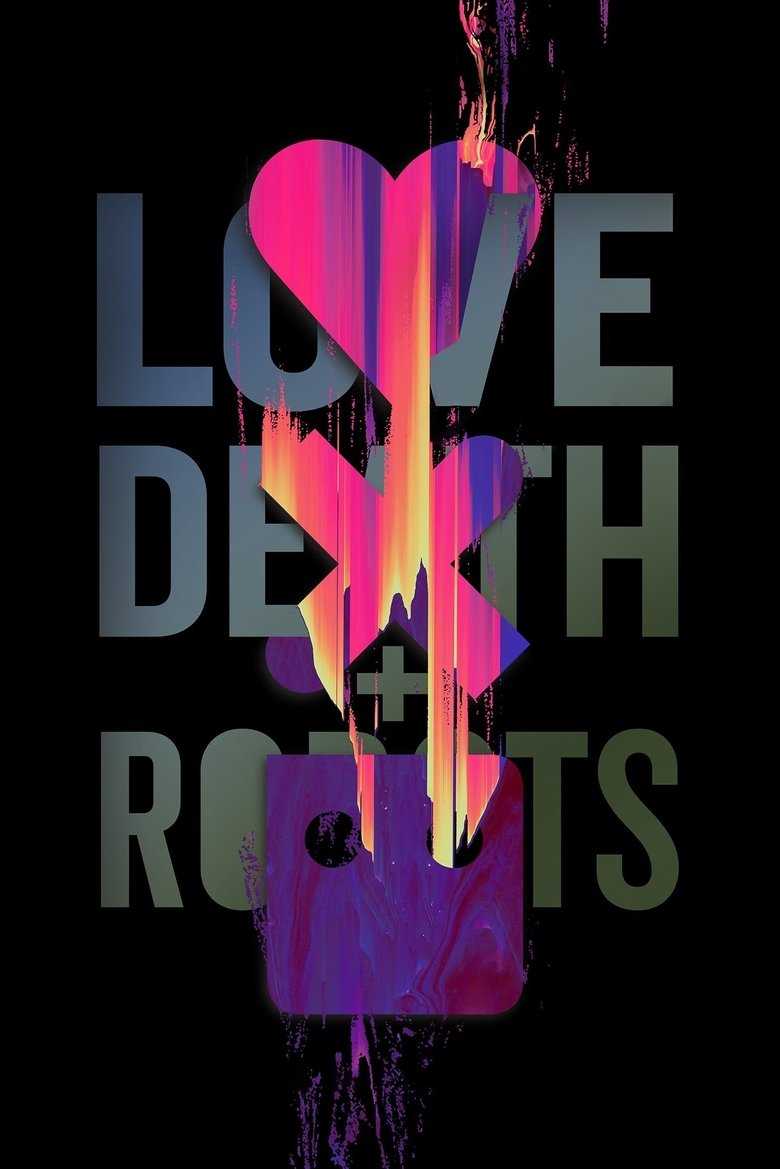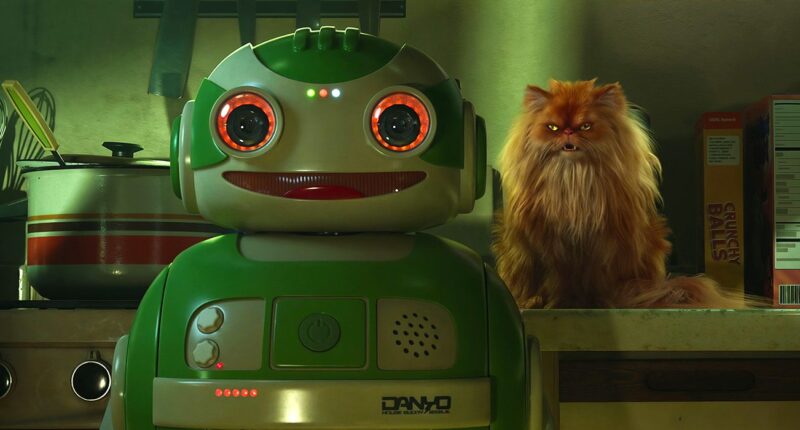Summary
- Collider’s Steve Weintraub talks with Tim Miller and Jennifer Yuh Nelson for Love, Death + Robots, Volume 4.
- In addition to the series’ 13 previous wins, Love, Death + Robots is nominated for Outstanding Animated Program and Outstanding Sound Editing for an Animated Program.
- In this exclusive Q&A, Miller and Nelson discuss the impact of advancing technology in animation, excitement and concern over AI, budget constraints, and more.
When it comes to pushing the boundaries of animation as far as they can go, there are few creative pairings willing to test the limits as Jennifer Yuh Nelson and Tim Miller. Nelson, an Oscar-nominated filmmaker best known for Kung Fu Panda 2 and 3, serves as supervising director on Netflix’s Love, Death, & Robots, constantly guiding the anthology series through production with numerous global animation studios in control of episodes. Miller, meanwhile, who created the series and continues to serve as showrunner, brings his talents for genre-bending to the groundbreaking series.
So far, Love, Death & Robots has won 13 Emmy Awards and is looking to secure more at this year’s ceremony following the release of Volume 4 earlier this year, which Collider’s Jeff Ewing reports has “some exceptional examples of unusual animation styles, and the various filmmakers involved have concocted many engaging genre explorations.”
Following a Collider special screening of Love, Death & Robots, Steve Weintraub hosted a Q&A with Miller and Yuh about the anthology series and the overall state of the animation industry, including how advancing technology can either help or hinder projects. The creative pair also provide insights into how they decide which episodes will be made for the series and which studio gets to take the reins on them, budgeting and timing constraints, and how, sometimes, making cuts is necessary for a variety of reasons.
Tim Miller and Jennifer Yuh Nelson Share Movies They Like (and Don’t Like)
Miller insists he’s not hard to please.
COLLIDER: Something that people might not realize about Tim is that Tim is hard to please when it comes to movies and TV. Would you agree?
TIM MILLER: Oh, no. I like a lot of stuff.
Sure.
MILLER: I don’t like everything.
So here’s my question for both of you to start this thing off: What’s the last movie or TV show you’ve seen that you’d like to recommend?
JENNIFER YUH NELSON: Oh, wow. I don’t see much. I’m, like, always working, so I don’t get to see anything. I don’t have any fun.
MILLER: You know what I’d say? You’ve asked me this question before, and I always say Dune. Well, not the second one, but the first one.
Literally, my second question is, “Tim, what’s better, Dune or Dune 2?
MILLER: I like Dune 1 because. Because in Dune 2, who was a hero? There were no heroes. I didn’t know who to root for. I like heroes.
Tim, one more question. Can you name another movie over the last five years that you’ve enjoyed?
MILLER: The Grey is probably outside your five years.
The Grey by Joe Carnahan? Yeah, that’s probably like 10, 15 years ago.
MILLER: Well, I’m old, Steve, so thank you for…
I’m just pointing out “hard to please.”
MILLER: By the time we’re done with this interview, I’ll have a few more.
NELSON: There’s a movie you didn’t like that I liked, which was The Substance.
MILLER: Oh, my God. Now, who here liked Substance? Raise your hand. Okay. Get out. Get out now.
I’m just trying to point out, Tim, hard to please.
The Changing Face of Animation Audiences
“I feel like that really opens the door for us.”
Anyway, in the last few years, I feel like animation has gotten more and more popular. I know I’m watching more of it, and I feel like so many people I know are also watching more of it. For the two of you, have you felt that from your position? Do you feel like more people are watching?
NELSON: I think it’s the quality of people watching, because I think before animation was considered more of a kid’s medium, now everybody’s watching it. It’s more like an international thing. People are raised on anime or international films, and now you can make things as demented and disturbing and incredibly complex in animation as you can do in live-action.
MILLER: And I think we have a whole generation of people who have grown up on video games, which are essentially adult animation on a lot of levels. It’s not a big transition to go to adult animation. I feel like that really opens the door for us. But it’s really the West. You’ve got to admit, Europe and Asia had a pretty big tradition of adult animation, and now Netflix has stolen all the Asian animators and made them work on Netflix shows. So, it’s probably destroying the Asian animation genre. Sorry, Netflix.
I will say that Netflix has reported it. I think Ted Sorrento has talked about how popular it is on the animation platform, and it’s fantastic because Netflix has what we call deep pockets and can make more animation stuff. But a thing for you, a lot of people don’t realize is that for a few years, you were the highest-grossing female director of all time.
NELSON: I didn’t get any of it, though. Somebody else did.
MILLER: But she did make me kneel every time I walked into the room while we were working on it.
For people who don’t realize, Kung Fu Panda 2 and 3.
NELSON: Yes.
It’s an amazing accomplishment, and I just wanted to give you flowers.
NELSON: Oh, thank you. I think it’s really great that it was actually surpassed quite quickly because so many more women filmmakers are making more and more box office and big films. So, I’m glad to have lost a title.
MILLER: If somebody told you you could again be the highest-grossing female director, would you do Kung Fu Panda 6?
NELSON: It depends on if I get to keep the money.
Why Animation Takes So Damn Long
“It’s a shame that we don’t do more animation here in Hollywood.”
For the two of you, what do you wish more people knew about making animation in Hollywood?
NELSON: It takes a bloody long time. So often people say, “Why didn’t it show up earlier?” It took a long time. It takes a long time to develop the scripts and to do the art. Each shot has to be hand-drawn or animated, or hand computer graphic by somebody. It’s basically a gigantic series of effects shots. Effects are probably the most expensive part of a film, other than maybe the $30 million you give to the A-list actor. But they’re so complicated, and the entire thing is effects, so it takes a long time. It takes two years to make a season, easily.
MILLER: I think everybody here probably knows this, but I’ll say it again. It’s a shame that we don’t do more animation here in Hollywood. As the owner of a company that is only Los Angeles-based, it’s hard for us. Even on Love, Death & Robots, I wish my company, Blur, could do every episode. But we really have to carefully choose the ones that we do because we can’t afford to. We’re more expensive, and it’s not because I’m making any fucking money. It’s because you give tax incentives or lower cost of living if we do it somewhere else. I really wish we could do more of it. I love our international partners. It’s amazing. But I wish we could do more of it here. Not like a MAGA way. I just mean because I like to talk to the animators.
You never really know what a show is going to do when it comes out. When did you first realize, “Oh wait, people really like Love, Death & Robots“?
MILLER: I’m still waiting. I’m still waiting to feel that love.
NELSON: Well, you show up wearing a shirt like that.
MILLER: Sorry, that was blatant pandering.
NELSON: You show up at a gas station wearing a shirt like that, and people approach you. That means you work on a show people like.
That’s true. Some people here are going to know this, but some people won’t. If you tried to make a heavy metal movie and if that heavy metal movie had happened, there would be no Love, Death & Robots.
MILLER: No, but there would be a heavy metal movie. Which would have been pretty fucking awesome.
Yeah, but that would have only been like 90 to 120 minutes. This has been way, way more than that. I will trade that heavy metal movie for four volumes of Love, Death & Robots.
MILLER: It didn’t even occur to us to try and do a series. Just because, despite my little bitch about costs and everything else, Netflix let us do the kind of animation that we wanted to do, which is not at a cost that Saturday morning animation is done. So, I’m so grateful that we got the money to do a really premium animation series. I didn’t think anybody would do that, so I’m still kind of amazed that they let us do that. We’ve never gotten a note from Netflix, ever, on any of our…
Wait, Jennifer is about to say something.
NELSON: I think we got, like, one.
MILLER: No, those are from me.
NELSON: Oh, okay.
MILLER: I gave a lot. But what did we get?
NELSON: I think we got one where we had a political figure, and it says, “Oh, that won’t age well.”
MILLER: Oh, yeah, there was a Trump joke. I still wish that was in there. But you know what? I think it was more of a suggestion than a note.
NELSON: It’s true. It was constant support. There was actually a lot of freedom with shows on what it was.
MILLER: It would have aged really well.
‘Love, Death + Robots’ Is Celebrating 13 Emmy Awards (and Counting, Hopefully)
“We’re making these things because we love them.”
The show has won a cumulative 13 Emmys. Which one means the most to you guys?
NELSON: Probably the first one, right?
MILLER: “Ice Age” by Robert Valley, though, when he won for that one. I think that one. I really love that short. I really love Robert Valley’s work in general. “400 Boys” is one of my favorites. And “Zima Blue” top of the list. So, “Ice Age” was an important one.
For the people in the audience who are not familiar with those titles, previous volumes.
NELSON: “400 Boys” was the first one that played.
Volume 4 is nominated for both outstanding animated program and outstanding sound editing for an animated program at the Emmys. While I think being nominated is everything, because how do you compare art to art, I do think winning matters because I want Netflix to keep making the series. So, what does it mean to you to be nominated yet again, especially for the big one?
NELSON: I think that it’s true. We work in a vacuum. We’re making these things because we love them, and we want to see them, but we don’t really know if other people love it. Something like this shows that not only do people love it, but they think that it is something beautiful, and that’s kind of amazing. It’s so encouraging. It makes all the hard work actually feel like it’s seen, and it’s worth it. So, awards by themselves don’t mean anything. It’s about the fact that people are showing you their appreciation about what you’re doing.
I agree.
MILLER: I’m very proud. I just wish that they had held back Arcane Season 2. Maybe just one more year. That would have shown a lot of appreciation from Netflix. I requested it, but they wouldn’t do it.
Something that people might not realize is how important this series is to the animation community. What’s so cool about it is how companies that are normally competitive are all working together to bring this series to life. Can you talk about its impact on the community?
NELSON: It’s amazing how a lot of these companies are VFX companies, or they do cinematics for video games or commercials. To be able to work on something that’s narrative and have this level of storytelling is something that they’ve always wanted to do, but they couldn’t do it scale. So something like an anthology. You have studios everywhere that range from five people to six, 700 people all working on different episodes, and they’re able to showcase everything they’re doing. Not only that, we’re showing them what the other episodes are while they’re doing it, which freaks them all out.
MILLER: It’s a total dick move that we do.
NELSON: It’s psychological warfare. But it makes everybody realize, “Oh my god, they’re doing this, and how are they doing that? How did they make that face and that skin look like that?” And then they one up each other, and they innovate off each other. And so, individually, they all get better. And these are all people, Tim often says, they’re competitors. They’re people that they’re bidding against each other for these jobs and everybody’s working together and encouraging each other and rooting for each other to do an amazing new thing.
[Jennifer], you’re the series’ supervising director. What exactly does that mean for people who don’t know what that means? What does your week look like?
NELSON: My week looks like chaos. There are 10 episodes, 10 studios, 10, maybe eight studios. If studios do more than one episode, 10 directors, all of them with different varying backgrounds, skill levels, focuses, have to deliver on the show with a high quality. That means each one requires a different kind of support. Some are just literally a little bit of therapy, and it’s okay. Some literally need me to go in and do a storyboard for a huge chunk of the episode. So, every day it’s support, it’s bespoke for everyone.
MILLER: But she’s also directing because she directed “Spider Rose,” which most people think, including me, might have been the best episode in this batch. So that, in itself, is a huge job.
How does it work behind the scenes, deciding what stories will be told in a volume?
NELSON: It’s a very organic process. We have on the wall these little index cards with a picture, sort of the tone of the story, and they each indicate one amazing short story that Tim might have had rattling around in the back of his brain for decades. So, we put them up there, and we see kind of what that tableau of contrasting stories and tones could be. Sometimes there may be a favorite, and we won’t be able to use it because there’s too much of the same thing, or sometimes it’s a story that nobody really considered as being a strong one, and then it suddenly rises as being a favorite. In the case of “Spider Rose,” that’s been rattling around since the very beginning.
MILLER: I was going to say leg wrestling, but she got to her explanation first.
NELSON: Look at my arm. Does this look like it would work?
MILLER: That’s why we do the leg thing where we have the opposite. She is right in that it is kind of a complicated puzzle because we want it to be a mix of styles and genres and tones. We want comedy, and we want horror, and we want sci-fi, and we want fantasy. We try to really cover the spread, which is really amazing when, at the end, we go, “Well, why are there so many cats? Why didn’t we think of not having so many cats, but we didn’t cover them?”
You can’t go wrong with too many cats.
MILLER: I think you can.
NELSON: He doesn’t like cats.
MILLER: I don’t like cats.
Again, did I mention something about Tim earlier?
MILLER: I like dogs a lot. Cats don’t like us either, so don’t give me that. They don’t like you. I don’t like them.
It’s just you.
MILLER: No, no, no. If you die tomorrow in your apartment, the cats will eat you.
NELSON: You could say that about some people. That’s okay.
‘Love, Death + Robots’ Creators on How Episodes Get Picked
“I think Jennifer goes in there at night when I’m not there and takes it off the board.”
We’re learning a lot about Tim tonight.
MILLER: But often we start the process of picking stories, and I’ll walk up to the board with full confidence in the authorities. “This motherfucking story is getting done. This is the one. Stamp it up there with a big thumbtack.” Then it just falls off the board at some point, and because we can’t afford to do that big one, or we can’t, there’s another one that another director might be right for more. You never know. The mix is always different.
Did you have any that were in Volume 1, 2, or 3 that you really wanted to do that ended up in Volume 4? How does that work? Is there one or some that has been just sitting there for a while, like “Spider Rose?” What was it that finally got it made?
NELSON: I think “Spider Rose” was one of the first, but it took “Swarm” to get it made because “Swarm” was a story that Tim had always said he wanted to do. So he made “Swarm” first.
MILLER: Lots of cool creatures. But there’s one called “Half Breeds”, which is Orcs vs Elves, and it follows the beats of the battle of the Zulus against the British and Isandwalla and Rourke Strift. I’m not shitting you. It’s awesome. And so that was in my heavy metal pitch book, and I’m still desperate to do it. But every time it’s like, “Oh my god, it’s armies of orks and elves, that’s going to be so expensive,” and then it gets taken off the board. I think Jennifer goes in there at night when I’m not there and takes it off the board.
I am curious, Jennifer, how did you decide that you wanted to do “Spider Rose,” because of how busy you are?
NELSON: Well, I get dibs on what story I want to do. That’s a perk of being a supervising director. It was the same with “Pop Squad.” It was the first story that I read that I really wanted to do, so I got to do that. “Spider Rose” is such a challenging story. It was always on the wall, and it was a special one, and it was so difficult that I actually looked at it and I thought, “In order to do it well and sort of respect what it was trying to do, I almost feel like I want to do that myself.” I could see it myself, and so I just took it. That’s kind of how it works.
You did which one? I can’t remember the title.
NELSON: “Scream of the Tyrannosaur” and “Golgotha.”
So how did you decide which ones you wanted to direct? Is it the same thing, like just cherry-picking?
MILLER: No, it was slightly different. “Scream of the Tyrannosaur,” I actually wrote for Zack Snyder. He said he wanted to do one, and I said, “Dude, I’ve got the most heavy metal story ever,” and it was “Scream of the Tyrannosaur.” So, I just went ahead and adapted the script, and then he said he couldn’t do it, and then I said, “Oh well. I guess we’ll have to shelve it.” And then Jennifer and Victoria, our producer, said, “No, come on, you want to do it, don’t you?” I’m like, “No, it’s for Zack. It’s not my tone,” but I did secretly want to do it, especially after I finished writing it. It’s dinosaurs and gladiatorial contests, super cool. And then “Golgotha”, Jennifer and I were gonna co-direct, and then I think she never said this out loud, but I think she’s like “I don’t want to go make decisions with Tim and have to leg wrestle.”
Again, you’ve seen the dynamic.
MILLER: And I can’t say I blame her, so at some point I just did it.
Obviously, you have a budget for each volume, and I’m just curious…
MILLER: No, Steve, it’s unlimited. We get as much money as we want.
I am curious, does it work out that you can do, like, 180 minutes of animation or 150 minutes of animation, or is it determined by what you’re including in these volumes? Like certain bits of animation cost more, certain things cost more. Can you take us behind the scenes in terms of figuring out where and when to deploy those resources?
NELSON: Well, the super-realistic CG is obviously the most expensive. It’s the most complex and most huge, most advanced sort of computer animation that can be done right now, as far as how to make people look not uncanny. So, those tend to be reserved for the big stories, usually the special ones that we’re talking about. But really, the strength of the show is the variety. If we had all shows to look identical to that, not only would it be ungodly expensive, but I think it would be ultimately a little less exciting, because people love to see the spread of all the different styles of animation and all the different ways you can approach it. You can have stop-motion, like basically the Christmas episode that we had the other season. The puppet for the monster Santa was the size of a turkey. And to be able to have a turkey-sized monster that you could touch with your finger…
MILLER: Why didn’t we get that in the end when it was done? Where is it?
NELSON: I think the director stole it.
MILLER: We should get that. We paid for it. We should get it.
NELSON: The director stole it! It’s in England.
MILLER: We should have gotten the turkey. I thought it looked like a giant testicle.
NELSON: It looked like a tumor. But yeah, you could have that and have the joy of having a giant turkey-sized piece of clay, or you could have a 2D episode. It is cheaper to do 2D, it just may take fewer people to do it.
MILLER: Between Love, Death & Robots and Secret Level, our show on Amazon, which we’re competing against for the Emmys, we’ve done 50 short films now. Then Blur does the short films in the form of cinematic, so animation is not making widgets, but there are certain patterns, so you get a sense of cost per minute. There’s complexity and caveats, but you get a sense of costs per minute for 2D, cost per minute for stop-motion, cost per minute for high-end CG, so you can kind of ballpark that and sort of put that puzzle together about what will fit in terms of style.
We got to a point in this season where I don’t think it was in this batch, but maybe I’m wrong, what your smart appliances are saying about you. We needed another episode. I wanted another episode in there, but we didn’t have any money, and so I told Victoria the producer. I said, “Look, I’m just gonna go into my house, and I’m gonna film my refrigerator, and then I’m gonna film my toilet and just a slow push in on each of those things with the voiceover because the voiceover will sell it.” And luckily, Jennifer and Victoria stopped saving me from myself and made it more of a stop-motion claymation piece, which is much better.
NELSON: But it was also done by a very, very talented group of generalists with like five or six guys out of their houses basically making it. It’s a very small company.
MILLER: I love high-end animation. I mean, my whole career is that, but I am still the little boy who drew the stick figure animation in my math book and, you know, flip the pages, which I love the fuck out of. So, I like everything. Donna Hersfeld’s little stick figure theater is like one of my favorite animation things on the web.
Matching the Right Studio to the Right Story
Sometimes it just takes the right bribe.
Listen, I love animation, and I love that more and more people are watching it. It’s fucking awesome. How do you figure out which company is gonna direct which piece of material?
MILLER: Bribes.
NELSON: Bribes. It could be tax incentives, sometimes, but mainly it’s about what that company is, especially, their big forte is, what they do. In the case of Unit, they do amazing skin. They did the best sort of faces and the facial acting of anyone and that’s why they did “Akila Rift”, because they had such beautiful fidelity of facial acting in the case of for “How Zeke Found Religion” that we just saw that was done by Titmouse, and they do incredible 2D animation hand-drawn animation Diego Peral did it, and he had actually direct done some animation on “Kill Team Kill” the previous season…
MILLER: Which Jennifer directed.
NELSON: Which is kind of crazy that I directed that one.
MILLER: No, it’s not, because she’s fucking dark. She looks really cute and nice, and she speaks softly, but she is dark. Very, very dark.
NELSON: But Titmouse does amazing 2D animation. So, sometimes, if we really want to work with the studio, we try to find a story that would be great in what they do.
A.I. Is Both “Exciting and Terrifying” for Animation
“I am both amazingly excited and terrified because I also read science fiction.”
How has technology in the last few years impacted the animation industry? Because I would imagine each year there are advances. How has it affected everything?
NELSON: I think, like with anything, it changes the speed at how things can be done and the expectations of what everybody does. Like things that looked beautiful, and we thought, “Oh, that’s cutting edge,” 10 years ago, even two years ago, it would be like, “No.” But now you can do more and more and more. You can make people look amazing. Also, audiences demand, so you have to go there. So, it’s always an arms race trying to find how to make the art look beautiful.
MILLER: But now all bets are off, so I think we’re gonna see a couple of years of real change in churn because the tools coming out of the AI world are pretty… That’s pretty disruptive.
That’s literally what my next question is. Let’s talk a little bit about AI.
MILLER: Oh, let’s! So exciting.
Let’s just touch on it. Are you both concerned about it? Are there certain things about AI that you’re excited to incorporate into the animation process? How frightened are people behind the scenes about AI?
MILLER: I’m a super nerd and I love science fiction, so I am both amazingly excited and terrified. I also read science fiction, and I made a Terminator movie, and I know what’s gonna happen. But it is undoubtedly going to be one of the greatest tools ever invented, not just for animation, but for the rest of the world. It might also destroy animation and the rest of the world, maybe, so I don’t really know where it is or where it’s going, because I think it’s just the beginning.
I just went to Annecy, which is a big festival in France. It’s like the biggest animation thing. The love for the show there was amazing, and then I went to another one in Spain called Mundo’s Digitalis, which is really great. So many young animators want to talk about the industry, and they love the show, and they’re so excited about their careers, but they all want to know, “What should I do with AI coming? How do I approach this from a career standpoint?” and I had nothing to say to them because I don’t know. So, the only piece of advice I can give them is, “Don’t ignore it. Don’t cover your eyes and think that it’s going away because it’s not.” I personally think that the next 12 months is about as far ahead as I want to look. It’s not about replacing what we do with AI; it’s about using the tools to make what we do faster, easier, better. I think it’ll be a similar pipeline for the next year or so, with us just using those tools to simplify and streamline things. But after that, I don’t know, because it’s changing, it feels like every week.
NELSON: Yeah, I think that it’s true. The thing that’s really driving the fear of a lot of people is how they are going to find work going forward, and I don’t think anyone really knows. I think what I hope to happen is that artists could use it as a tool for themselves, but I hope that companies won’t use it to replace artists if that makes sense.
MILLER: My standard line, because you asked about how people think about it inside the industry, and I believe this to be true, but I don’t want to use AI tools to tell the same story with less people. I want to tell bigger stories, and that is the reason why I’m excited. For instance, there’s a book I’m adapting by China Mayville called Perdido Street Station. It’s an amazing book, but it would be so expensive to do. It’s a city full of strange creatures and robots and monsters and everything, and it would just be prohibitively expensive, and it’s not a broad four-quadrant movie. I’m sure everybody would know that that’s not what it’s going to be for me, but I could never tell that story, but with AI maybe augmenting the budget, I can tell a different kind of story because I can afford to tell a non-four-quadrant story, because with the tools it gets cheaper, faster, better. I’m excited about that.
This ‘Love, Death + Robots’ Episode Could Get the Series Treatment
If it was a movie, though, it’d be “Sunny’s Edge.”
One of the things about Love, Death & Robots is that some episodes are five minutes long, some are 10, some are 12 or 15, and if you’re named David Fincher, you get 20. I’m just curious, how do you decide to have episodes that are 10 minutes that you would have loved to have been 20, and you have to pull it to 10 because that’s what you can afford? How do you decide the runtime on some of these things?
NELSON: It sometimes just comes down to how much money we have for the episode. I think, ideally, some stories, the stories we choose, are ones that can be told in the time that we have. We don’t want to cripple a story and jam it into a little box, but there are stories that are like 50 pages, and we just couldn’t do them because we just don’t have the time.
TIM MILLER: I do generally think, though, that, and this is over a career of doing it, directors often think, “I can’t cut anything else. I can’t. It’s the leanest it can possibly be.” But when they are forced to cut more, it gets better. My “Scream the Tyrannosaur” had a thing that happened midway through when this company, Axis, in Scotland, which is one of our favorite partners, went bankrupt right in the middle of my short, “Scream the Tyrannosaur,” and they literally held the hard drives hostage. Not them, but the bank, I guess. We had to fly a producer over there with $20,000 in a dark alley and exchange money for hard drives. But when we came back and brought it back to Blur, the show came out in mid-May, and we didn’t start finishing the show until January, and it was 14 and a half minutes. There was no way we could do it, so I said, “I’m gonna cut that fucker down.” I got it down to 11 and a half minutes, which is really hard for me to believe, because if you had asked me before that happened I would have said, “I’m not cutting a shot. Every shot that’s in there has to be there. It’s important I tell this story.” Then, when it’s gone, I’m like, “I don’t miss it.” Maybe it could have been 12 and a half, but I miss some of it, but it really does get better, and directors can’t do it. Often, if I was working on Terminator or Deadpool, the editor would cut things out when I was out of the room, like doing VFX reviews or something, so I wouldn’t know, because if I was there, I would go, “No, you can’t cut that shot,” but then when it’s gone you realize it’s better.
For people that may not know Tim’s resume, by the way, he directed the first Deadpool. Nothing you’ve seen.
MILLER: In the future, just say the best Deadpool instead of the first, and then let them figure out which one.
Noted. If you could get one of the episodes made into a TV show or feature film, which is the one that you would love to flesh out and do more with?
NELSON: I’ll say, just selfishly, I wish we could do a whole recurring show of “Kill Team Kill” and just kill them every time and come back more cybernetically enhanced, just worse and worse each time. Those guys will die and come back and die and come back. But the conventional thing is probably “Three Robots”, because everybody loves “Three Robots.”
MILLER: We have a pitch for TV, so if you want to petition Netflix, we have a whole TV series. “Three Robots” is laid out. But if it was a movie, “Sunny’s Edge”.
Netflix has talked about… No, let’s skip that one…
MILLER: I tried to talk a lot because I knew Steve didn’t do his homework and didn’t have a lot of questions there. So I said I’ll talk a lot and bullshit more.
By the way, thank you for protecting me. I really do appreciate you trying.
MILLER: I’m trying to cover for you. Because you’re a good person, Steve.
Fuck off! That is a joke.
MILLER: That’s called a callback in the industry, ladies and gentlemen.
The Shots That Break the Bank
Blur is working on a lot of things right now, but nothing that can be talked about.
One of the things I don’t think people realize is that certain shots cost a lot more money than others, so I’m just curious. What is a shot that is a lot more money than people would realize, and what’s something that looks like it costs a shit-ton but it’s actually not that hard to do?
NELSON: Oh my gosh. You know, one of the benefits of being creative rather than a producer is that I don’t worry about the money. I just look at that and go, “Does it look bloody great or not?” and then you have somebody else try to negotiate you down.
MILLER: I think there’s a weird reversal that happens between live-action and CG, because the cheapest thing you can do on a live-action set is to put the camera right here on an actor’s face, and you get all the subtlety of this performance. In CG, facial close-ups are the hardest shots to do. You have a big chunk of your gray matter there just to decode the content of the human face, and when it’s not right, you sense it. You may not be able to go, “The corner of the mouth is not turning down as much,” but your brain will pick it up. Oddly enough, women are twice as fast at registering those anomalies than men are because we’re just generally more dense, I guess. But you may not know what it is, but you sense that something’s off, and it bothers you. So you spend a lot of time going, “Hmm, something’s not right there with that shot.” But with a camera, you just go there, and it’s done. But things like blood pouring out of a dinosaur, that’s easy.
You mentioned Blur already, but for the future, what is Blur currently working on that you want to tease?
MILLER: Nothing. We’re working on a lot of stuff. We continue to do service work.
I was gonna say, there’s no way Blur is not doing a ton of stuff right now.
MILLER: You know we’re doing a lot of stuff, Steve, but we can’t talk about it. I still hope we get to do our first movie. I got into this industry going, “I’m gonna own a studio so I can do a movie,” and 30 years later, I’m going, “I’m gonna own a studio so I can do a movie.” Animated, animated.
This was not what I was gonna ask you. I just realized this question. You know David Ellison a little bit. Are you excited for him to — don’t get yourself in trouble — have the keys to Paramount?
MILLER: God damn, Steve.
Again, answer carefully.
MILLER: I have a lot of respect for David Ellison because I know he loves film. We all wish that that political morass was less sticky to get there, but I am glad that Paramount is gonna remain an independent studio. That’s what I’ll say about it.
I’ll also say that David does love movies. I wish some of them were better, but he does love movies.
MILLER: Wow! They’re never gonna get you on a junket.
Listen, people who read Collider know when we love something, we go to bat for it. If you make something shitty, we’re gonna call you out on it. That’s just the way it is, and Skydance, which is what David owns, has made some really good movies, and they’ve made some pieces of shit, and if you can’t be honest about that, then you should not be talking about movies.
MILLER: I’m not defending anybody, but you can’t really point to any studio and say…
Oh, 100%.
MILLER: “You’ve made some really good movies, and you’ve made some really bad movies.” I mean, look, some people might say I’ve made a really good movie and a really bad movie, but I love my Terminator movie, even though it didn’t do well.
I’m gonna defend you here, and we’ve sort of touched on it. You made a good Terminator movie. The issue, I think, is that Terminator has a finite amount of money at the box office. It’s not a billion-dollar franchise; it’s like a 300 million-dollar movie or a 400 million-dollar movie, and the problem with your Terminator is it costs a lot of money, but it’s not like it bombed and made like 20 million dollars.
MILLER: It’s in the black now.
I could be wrong, but didn’t it make like $300 million or so?
MILLER: $280.
That’s my point.
MILLER: And then it’s made the number one movie on Netflix for months.
That’s my point. That’s not a bomb, it’s just your movie cost a lot, so it’s harder to be profitable.
MILLER: That wasn’t my fault. I wanted to cut stuff, but they wouldn’t let me. I will say, the problem with all of this and making movies, whether it’s Skydance or Warner Bros., is that you have a whole group of people who think they know movies, including me. I’m like, “This is the greatest idea ever. Please do it.” Your interview with Guillermo for Pacific Rim was really great, where Guillermo says, “I’ve made 12 movies, I’ve been so fortunate, and everybody thinks, ‘Oh, I’m Guillermo, I could just call and say greenlight my movie,’ but I’ve developed 42 movies and I loved each of them as much as the ones I actually made.” I feel that same way. I’m not talking out of school here when I said “Can’t Stop” the music video, we got a lot of online hate for that maybe it was leading off with it, maybe it was people were pissed off we did a music video, I don’t know why. I loved it, but some people didn’t like it, but I can’t control that. I can’t. You can’t chase what you think is gonna make people happy.
Love, Death, & Robots is now streaming on Netflix.

Love, Death & Robots
- Release Date
-
March 15, 2019
- Network
-
Netflix
- Directors
-
Víctor Maldonado, Patrick Osborne, Robert Valley, Alfredo Torres Martínez, Jerome Chen, Emily Dean, Rémi Kozyra, Léon Bérelle, Dominique Boidin, Alberto Mielgo, Maxime Luère, Andy Lyon, Robert Bisi, Dave Wilson, David Nicolas, Simon Otto, Damian Nenow, Laurent Nicolas, Kevin Van Der Meiren, Vitaliy Shushko, Owen Sullivan, István Zorkóczy, Javier Recio Gracia, Oliver Thomas


















